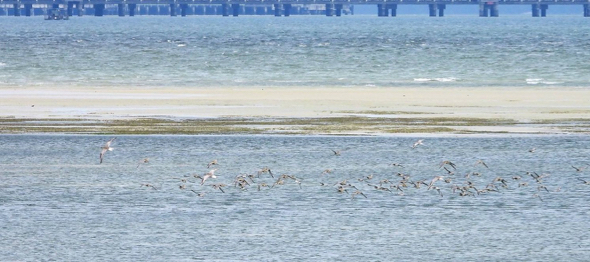The number of shorebirds sighted at Chek Jawa is impressive. “I may not be able to identify all the birds but it still is an enjoyable experience seeing them despite being under the hot sun with the wind blowing on us and our cameras shaking like mad,” so says MeiLin Khoo, who dreams that one day an extended bridge/broadwalk will be built to allow nature lovers be closer to the spectacular displays by these swarning birds.
Chek Jawa’s rich marine biodiversity is sited at the eastern shore of the offshore island of Pulau Ubin LINK.
The area was slated for reclamation and the Nature Society (Singapore), then at the forefront of the local nature conservation scene, gave up hope of saving the area. However, individuals like Joseph Lai, N. Sivasothi and Ria Tan came forward to publicise the uniqueness of the area. This caught the imagination of the public and hundreds visited the site PDF. This in turn caught the attention of the then National Development Minister, Mr. Mah Bow Tan, who visited the area, was visibly impressed and belatedly announced a reprieve for Chek Jawa.
MeiLin Khoo
Singapore
3rd February 2019
This post is a cooperative effort between Birds, Insects N Creatures Of Asia and BESG to bring the study of birds and their behaviour through photography and videography to a wider audience.












One Response
Just wanted to mention that the large numbers of shorebirds were more than the usual and lasted only for a day or two. They were probably either on passage, passing through, or displaced from another nearby feeding area (perhaps by reclamation activity).
I also wanted to comment that while many of us would like to be closer to such spectacles, it is for the very reason that we are not that such spectacles occur, as wild animals are sensitive and should be given sufficient space from us observers.
An extension of the boardwalk is a really bad idea as it is crucial to have a protion of Chek Jawa left alone and away from the crowds and noise, so that wildlife can forage in peace. Besides, Chek Jawa is about the entire natural area of 7 or so habitats and all their inhabitants….not just the birds!
Decisions on how to balance between the needs of the wildlife and the enjoyment of the visitors was carefully considered by NParks with feedback from nature groups, before the current boardwalk was built.